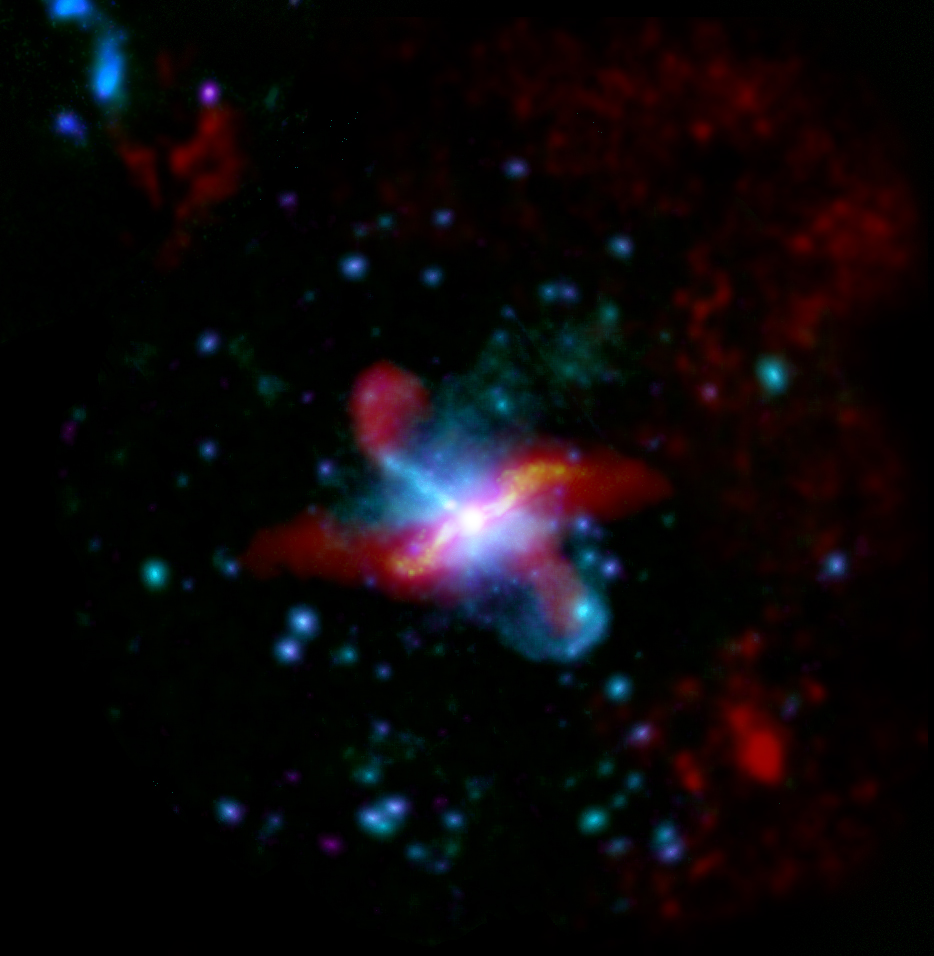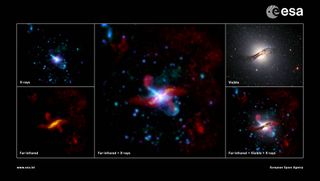Cosmic Collision Likely Spawned Massive Nearby Galaxy

An enormous nearby galaxy traces its birth to a cataclysmic collision between two older galaxies, new observations from two European spacecraft suggest.
Previous images in visible light have hinted at a complex inner structure in Centaurus A, a giant elliptical galaxy found about 12 million light-years from Earth. The new views — captured in infrared and X-ray wavelengths by the European Space Agency's Herschel and XMM-Newton space observatories, respectively — map out that structure in greater detail and strengthen theories about its violent origins, researchers said.
Herschel was able to peer through Centaurus A's central band of obscuring dust. The telescope's images reveal the flattened inner disk of a spiral galaxy whose shape is probably due to a merger with an elliptical galaxy long ago, researchers said.
Herschel's data also uncover evidence for rapid star birth toward the center of Centaurus A (which is also known as NGC 5128), along with two jets emanating from the galaxy's core, one of which is about 15,000 light-years long.

"The sensitivity of the Herschel observations enables us to see not only the glow from dust in and around the galaxy, but also emission from electrons in the jets spiralling in magnetic fields at velocities close to the speed of light," Herschel project scientist Göran Pilbratt said in a statement.
The XMM-Newton spacecraft recorded the high-energy glow from one of the jets. The telescope's observations show how the jet interacts with the surrounding interstellar matter and also reveals Centaurus A's intensely active nucleus and its large gaseous halo, researchers said.
"XMM-Newton is well suited to detecting extended weak X-ray emission, often allowing us to see halos around galaxies for the first time," said XMM-Newton project scientist Norbert Schartel.
Get the Space.com Newsletter
Breaking space news, the latest updates on rocket launches, skywatching events and more!
The jets seen by both satellites are evidence of the supermassive black hole that likely lurks at the center of Centaurus A, containing about 10 million times the mass of our own sun, researchers said.
Follow SPACE.com for the latest in space science and exploration news on Twitter @Spacedotcom and on Facebook.
Join our Space Forums to keep talking space on the latest missions, night sky and more! And if you have a news tip, correction or comment, let us know at: community@space.com.

Space.com is the premier source of space exploration, innovation and astronomy news, chronicling (and celebrating) humanity's ongoing expansion across the final frontier. Originally founded in 1999, Space.com is, and always has been, the passion of writers and editors who are space fans and also trained journalists. Our current news team consists of Editor-in-Chief Tariq Malik; Editor Hanneke Weitering, Senior Space Writer Mike Wall; Senior Writer Meghan Bartels; Senior Writer Chelsea Gohd, Senior Writer Tereza Pultarova and Staff Writer Alexander Cox, focusing on e-commerce. Senior Producer Steve Spaleta oversees our space videos, with Diana Whitcroft as our Social Media Editor.